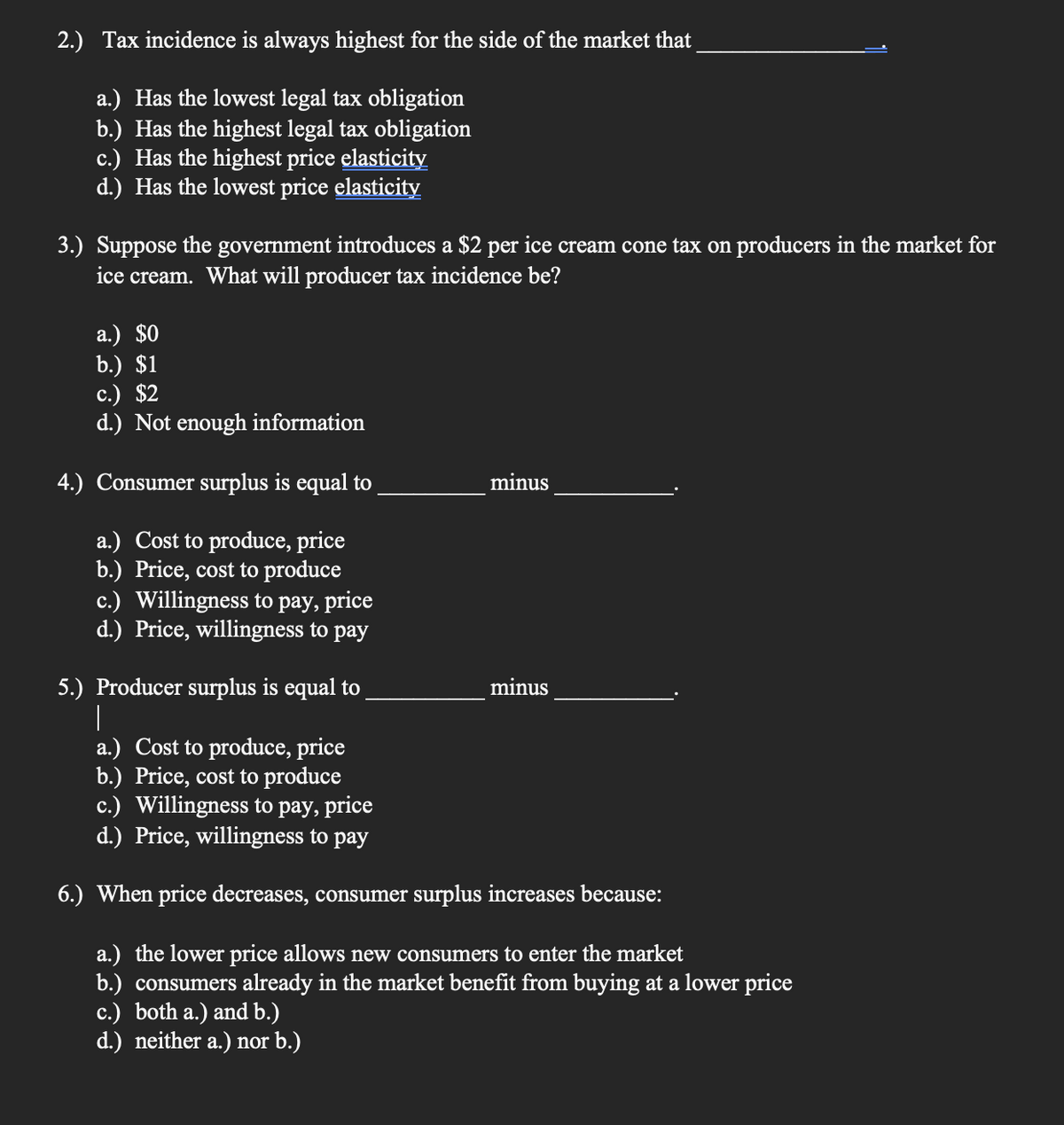2.) Tax incidence is always highest for the side of the market that a.) Has the lowest legal tax obligation b.) Has the highest legal tax obligation c.) Has the highest price elasticity d.) Has the lowest price elasticity 3.) Suppose the government introduces a $2 per ice cream cone tax on producers in the market for ice cream. What will producer tax incidence be? a.) $0 b.) $1 c.) $2 d.) Not enough information 4.) Consumer surplus is equal to minus a.) Cost to produce, price b.) Price, cost to produce c.) Willingness to pay, price d.) Price, willingness to pay
2.) Tax incidence is always highest for the side of the market that a.) Has the lowest legal tax obligation b.) Has the highest legal tax obligation c.) Has the highest price elasticity d.) Has the lowest price elasticity 3.) Suppose the government introduces a $2 per ice cream cone tax on producers in the market for ice cream. What will producer tax incidence be? a.) $0 b.) $1 c.) $2 d.) Not enough information 4.) Consumer surplus is equal to minus a.) Cost to produce, price b.) Price, cost to produce c.) Willingness to pay, price d.) Price, willingness to pay
Principles of Microeconomics
7th Edition
ISBN:9781305156050
Author:N. Gregory Mankiw
Publisher:N. Gregory Mankiw
Chapter8: Application: The Cost Of Taxation
Section: Chapter Questions
Problem 1CQQ
Related questions
Question

Transcribed Image Text:2.) Tax incidence is always highest for the side of the market that
a.) Has the lowest legal tax obligation
b.) Has the highest legal tax obligation
c.) Has the highest price elasticity
d.) Has the lowest price elasticity
3.) Suppose the government introduces a $2 per ice cream cone tax on producers in the market for
ice cream. What will producer tax incidence be?
a.) $0
b.) $1
c.) $2
d.) Not enough information
4.) Consumer surplus is equal to
minus
a.) Cost to produce, price
b.) Price, cost to produce
c.) Willingness to pay, price
d.) Price, willingness to pay
5.) Producer surplus is equal to
minus
a.) Cost to produce, price
b.) Price, cost to produce
c.) Willingness to pay, price
d.) Price, willingness to pay
6.) When price decreases, consumer surplus increases because:
a.) the lower price allows new consumers to enter the market
b.) consumers already in the market benefit from buying at a lower price
c.) both a.) and b.)
d.) neither a.) nor b.)
Expert Solution
This question has been solved!
Explore an expertly crafted, step-by-step solution for a thorough understanding of key concepts.
Step by step
Solved in 2 steps

Knowledge Booster
Learn more about
Need a deep-dive on the concept behind this application? Look no further. Learn more about this topic, economics and related others by exploring similar questions and additional content below.Recommended textbooks for you

Principles of Microeconomics
Economics
ISBN:
9781305156050
Author:
N. Gregory Mankiw
Publisher:
Cengage Learning

Principles of Macroeconomics (MindTap Course List)
Economics
ISBN:
9781305971509
Author:
N. Gregory Mankiw
Publisher:
Cengage Learning

Principles of Economics (MindTap Course List)
Economics
ISBN:
9781305585126
Author:
N. Gregory Mankiw
Publisher:
Cengage Learning

Principles of Microeconomics
Economics
ISBN:
9781305156050
Author:
N. Gregory Mankiw
Publisher:
Cengage Learning

Principles of Macroeconomics (MindTap Course List)
Economics
ISBN:
9781305971509
Author:
N. Gregory Mankiw
Publisher:
Cengage Learning

Principles of Economics (MindTap Course List)
Economics
ISBN:
9781305585126
Author:
N. Gregory Mankiw
Publisher:
Cengage Learning

Essentials of Economics (MindTap Course List)
Economics
ISBN:
9781337091992
Author:
N. Gregory Mankiw
Publisher:
Cengage Learning

Principles of Macroeconomics (MindTap Course List)
Economics
ISBN:
9781285165912
Author:
N. Gregory Mankiw
Publisher:
Cengage Learning

Principles of Microeconomics (MindTap Course List)
Economics
ISBN:
9781305971493
Author:
N. Gregory Mankiw
Publisher:
Cengage Learning